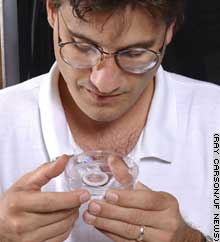A scientist from Florida developed a "brain" in a glass plate that was able to fly a virtual jet plane, and could advance the scientific understanding of neurological disorders such as epilepsy
Avi Blizovsky

Direct link to this page: https://www.hayadan.org.il/petribrain.html
CNN reports that Thomas DeMarse, a professor of biomedical engineering at the University of Florida, developed a "brain" in a glass plate, which was able to fly a virtual jet plane, and which could advance the scientific understanding of neurological disorders such as epilepsy.
The "living computer" grew from 25 thousand neurons that were removed from the brain of a rat and organized around a network of 60 electrodes in a Petri dish. When they connected the saucer to a simulator of an F22 jet plane, the brain and the simulator established a bilateral relationship similar to the one that neurons receive and interpret signals from each other and control our body.
Plate with 60 electrodes
The brain cells began to bind to each other, forming microscopic interconnections. "It's actually a plate with 60 electrodes attached to the bottom. We inserted nerves from the cerebral cortex of mice into the plate above the neurons, which quickly began to connect to each other, creating a living neural network, or in other words - a brain," explained de Mars.
Although such a neural network could one day, for example, fly a drone, DeMars claims that the research is of more immediate relevance as an auxiliary experiment for understanding the way in which the human brain performs and learns computational operations at the cellular level. "We are interested in the question of how the brain performs calculations," he said.
Like memories from the age of five
"It's a huge ability for the brain, when a certain person is asked questions, to retrieve, for example, memories from the age of five. In fact, the brain can perform simple operations that you think a computer can do easily, but in fact it is not. Computers lack the flexibility and adaptability of the human brain and are very weak at pattern recognition tasks. If we can uncover the rules by which neural networks operate and perform pattern recognition type calculations, we can produce a completely new type of computer systems," he added.
"There are many data that show that the calculation we have here is not based on just one neuron. The ability to calculate is actually a developing feature associated with hundreds of thousands of neurons that work together and produce the amazing processing capacity of the brain", concluded de Mars.
Clues to brain malfunctions
In addition to increasing scientific knowledge about how the brain works, these neurons may provide clues to brain failures. For example, an epileptic attack (falling disease), which occurs when all the neurons in the brain burst electrically at once - a pattern that is also carried out by the neural network in the plate.
For news on CNN
The brain savant
https://www.hayadan.org.il/BuildaGate4/general2/data_card.php?Cat=~~~993720496~~~204&SiteName=hayadan
